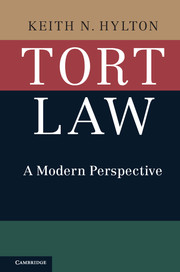Book contents
- Frontmatter
- Contents
- 1 Introduction
- 2 Policy and Tort Law
- 3 Evolution of Tort Law
- 4 Intentional Torts
- 5 Theoretical Foundations of Strict Liability
- 6 The Reasonable Person
- 7 Customs, Statutes, and the Reasonable Person
- 8 Inferring Negligence
- 9 Contributory Negligence and Assumption of Risk
- 10 Contributory Negligence, Comparative Negligence, and Incentives for Care
- 11 Joint and Several Liability, and Vicarious Liability
- 12 Factual Causation
- 13 Proximate Cause
- 14 Duty to Rescue and Special Relationships
- 15 Strict Liability: Conversion, Abnormally Dangerous Activities, and Nuisance
- 16 Defamation
- 17 Products Liability
- 18 Damages
- Index
12 - Factual Causation
Published online by Cambridge University Press: 05 June 2016
- Frontmatter
- Contents
- 1 Introduction
- 2 Policy and Tort Law
- 3 Evolution of Tort Law
- 4 Intentional Torts
- 5 Theoretical Foundations of Strict Liability
- 6 The Reasonable Person
- 7 Customs, Statutes, and the Reasonable Person
- 8 Inferring Negligence
- 9 Contributory Negligence and Assumption of Risk
- 10 Contributory Negligence, Comparative Negligence, and Incentives for Care
- 11 Joint and Several Liability, and Vicarious Liability
- 12 Factual Causation
- 13 Proximate Cause
- 14 Duty to Rescue and Special Relationships
- 15 Strict Liability: Conversion, Abnormally Dangerous Activities, and Nuisance
- 16 Defamation
- 17 Products Liability
- 18 Damages
- Index
Summary
A negligence action can be broken down into four components: duty, breach, causation, and damages. The causation prong subdivides further into factual and proximate causation. We looked closely, in Chapter 9, at some factual and proximate causation issues in contributory negligence cases. This chapter examines factual causation doctrine in isolation and derives some rules for navigating this most intractable part of tort law.
The hornbooks and casebooks offer abstract causation rules that sometimes fall short of explaining the outcomes of particular cases. There are many decisions in which judges seem to make special exceptions to the abstract rules. The student feels pressure, at some point, to either stick to the rules, in the hope of finding reasonable guidance, or try to understand the decisions on a case-by-case basis. Focusing on individual cases, however, could cause one to lose sight of the rules and, more importantly, the policies in this area. In an effort to resolve this dilemma, I have articulated rules in this chapter at a high level of detail, with an emphasis on functional justifications.
CAUSE IN FACT
The traditional approach to factual causation seeks to determine whether the injury would have happened even if the defendant had taken care. This is known as the but-for test: Causation can be established if the injury would not have happened but for the defendant's negligence. The but-for test is satisfied only if the defendant's negligence is a necessary condition for the injury.
Basics
As a preliminary matter, there is one strikingly prominent source of confusion in the but-for analysis of causation. Take the case of death: My negligent conduct leads to your death; for example, by driving negligently I run you over with my car, killing you. One thing certain in life is death. Hence, it would appear that I have a pretty good factual causation defense against the negligence lawsuit brought by your survivors: You would have died at some point anyway. Doesn't it follow, then, that any tort suit brought in response to a negligent killing must be rejected on factual causation grounds?
Unsurprisingly, the courts do not accept this reasoning. A sufficient policy rationale is that if such a defense were accepted, tort law would unravel.
- Type
- Chapter
- Information
- Tort LawA Modern Perspective, pp. 195 - 226Publisher: Cambridge University PressPrint publication year: 2016
- 1
- Cited by



